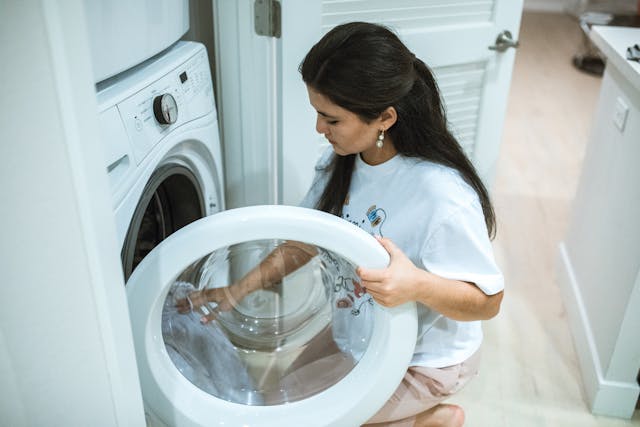A clogged washing machine can turn an otherwise simple laundry day into a frustrating ordeal. Whether caused by lint buildup, soap residue, or foreign objects stuck in the drain, a clogged washing machine can lead to inefficient washing, foul odors, and even water damage. In this guide, we’ll explore how to clean clogged washing machine systems effectively, including actionable steps for clearing drain pipes, unclogging hoses, and maintaining your washer to prevent future issues.
This article covers everything you need to know about cleaning clogged washing machines—from identifying common causes of blockages to practical cleaning techniques and preventive maintenance tips. Whether you’re dealing with a clogged washer drain hose, a blocked pipe, or a slow-draining washer, the methods outlined here will help you restore your washing machine’s efficiency and extend its lifespan.
Why Washing Machines Get Clogged
Washing machines are workhorses of the modern home, but they’re not immune to wear and tear. The most common reasons for clogs in washing machines include:
- Lint and Debris: These can accumulate in the washer drum, drain pipe, and hoses, leading to clogs.
- Soap Residue: Detergents can leave behind sticky residue that builds up over time.
- Foreign Objects: Items like coins, buttons, and socks often get stuck in the washing machine’s drain system.
- Hard Water Deposits: Mineral buildup in the pipes can also contribute to blockages.
Addressing these issues promptly is crucial for maintaining your machine’s performance. With the following steps, you can clean clogged washing machine components and keep your laundry routine running smoothly.
Understanding the Washing Machine Drain System
To clean a clogged washing machine, it’s important to understand its drain system. Water drains from the washer drum through a hose and into the home’s plumbing. Key components include:
- Drain Hose: Connects the washer to the drain pipe.
- Drain Pipe: Carries water away from the machine.
- Pump Filter: Prevents large debris from entering the pump.
Regular cleaning of these components ensures proper drainage and reduces the likelihood of clogs.
Signs of a Clogged Washing Machine
Recognizing the symptoms of a clogged washing machine can help you take timely action. Common signs include:
- Slow Draining: Water takes longer to leave the washer drum.
- Standing Water: Residual water remains after the cycle ends.
- Unpleasant Odors: Stagnant water can cause bad smells.
- Error Codes: Many modern washers display error codes when drainage issues occur.
If you notice any of these signs, it’s time to clean clogged washing machine parts to restore functionality.
How to Clean the Washer Drain Pipe
The drain pipe is a common area for clogs. Follow these steps to clean it:
- Turn Off the Washer: Disconnect it from the power supply for safety.
- Locate the Drain Pipe: Usually at the back of the washer.
- Inspect for Blockages: Use a flashlight to look for visible debris.
- Flush the Pipe: Use a garden hose or drain cleaning solution to clear the pipe.
- Reattach the Pipe: Ensure a secure connection to prevent leaks.
Regular maintenance can prevent buildup in the drain pipe.
Cleaning the Washing Machine Drain Hose
The drain hose often traps lint, hair, and detergent residue. Here’s how to clean it:
- Disconnect the Hose: Unscrew it from the washer and the drain pipe.
- Clear Blockages: Use a plumber’s snake or a long brush.
- Rinse Thoroughly: Run water through the hose to remove residue.
- Reinstall the Hose: Check for kinks that might restrict water flow.
This simple procedure can greatly improve drainage efficiency.
How to Unclog the Pump Filter
The pump filter is designed to catch debris before it reaches the pump. Cleaning it is straightforward:
- Locate the Filter: Found near the bottom of most washers.
- Remove the Filter Cap: Have a towel ready to catch water.
- Clean the Filter: Remove lint, hair, and foreign objects.
- Reassemble: Secure the filter cap before running the machine.
Regular cleaning prevents damage to the pump and ensures smooth operation.
Using Natural Cleaners to Remove Clogs
Natural cleaners are effective for clearing minor clogs and maintaining a fresh machine. Try these options:
- Baking Soda and Vinegar: Pour 1 cup of each into the washer drum and run a hot water cycle.
- Lemon Juice: Breaks down soap scum and mineral deposits.
- Salt and Hot Water: Dissolves grease and residue in pipes.
These eco-friendly methods can help you clean clogged washing machine components without harsh chemicals.
How to Prevent Washing Machine Clogs
Prevention is better than cure. Follow these tips to avoid clogs:
- Use a Mesh Bag: Prevents lint and small items from entering the drain.
- Run Maintenance Cycles: Use hot water and cleaning agents periodically.
- Avoid Overloading: Excess laundry can strain the machine and block drains.
- Check Pockets: Remove objects before washing.
Implementing these habits will keep your washer running smoothly.
When to Call a Professional
While DIY methods work for minor clogs, some situations require expert help:
- Persistent Blockages: If the clog doesn’t clear after cleaning.
- Damaged Components: Broken hoses or filters need replacement.
- Electrical Issues: Problems with the drain pump motor.
A professional plumber or appliance technician can diagnose and fix complex problems.
Choosing the Right Cleaning Tools
Having the right tools makes cleaning clogged washing machines easier. Essential items include:
- Plumber’s Snake: Clears deep blockages in hoses and pipes.
- Drain Cleaning Brushes: For scrubbing residue.
- Wet/Dry Vacuum: Removes standing water and debris.
- Drain Cleaning Solutions: Breaks down tough clogs.
Investing in these tools ensures efficient maintenance.
Extending the Lifespan of Your Washing Machine
Proper care doesn’t just fix clogs; it extends the life of your machine. Regular maintenance includes:
- Cleaning After Every Use: Wipe down the drum and door seal.
- Descaling: Prevents mineral buildup in hard water areas.
- Inspecting Hoses: Replace worn or damaged hoses.
- Annual Professional Servicing: Ensures optimal performance.
By taking these steps, you can avoid costly repairs and enjoy a reliable washing machine for years.
Conclusion
Clogged washing machines are a common yet solvable problem. With the tips outlined in this guide, you now have the knowledge to clean clogged washing machine components effectively and maintain your appliance for long-term performance.
From understanding the causes of clogs to employing DIY cleaning techniques and preventive measures, keeping your washing machine in top shape is easier than you might think. By staying proactive, you’ll save time, money, and the hassle of dealing with a malfunctioning washer.
So, the next time you face a clogged washing machine, remember the steps detailed here and tackle the issue with confidence. Your washing machine—and your laundry routine—will thank you!





